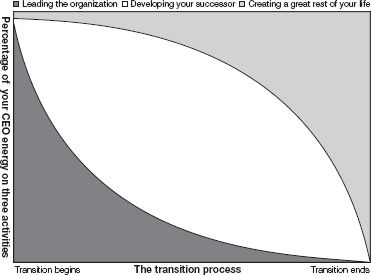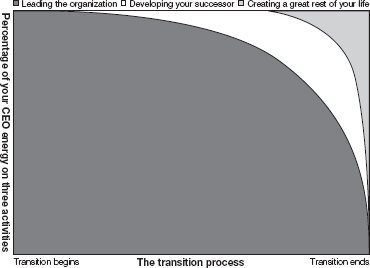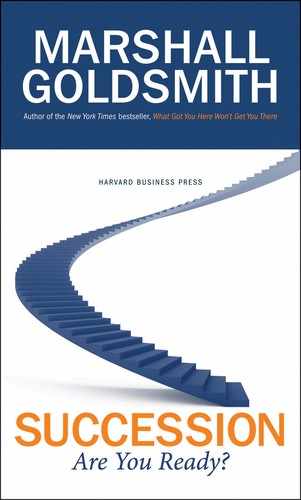1 Slowing Down
You are carrying the baton in a very special relay race. As the CEO, you have been given the privilege of carrying the baton of leadership. If you do a great job of carrying this baton, your organization may last long beyond your tenure. You have been given this extraordinary baton for only a short segment of your organization’s life. At some point in time, you will need to hand it off to another leader who will take your place. You will be amazed at how quickly this time passes! Will you—and your successor—be ready for this handoff?
Passing the Baton of Leadership
Unlike a relay race in the Olympics, your relay has some very different rules. To begin with, if your organization continues to prosper, a series of baton carriers can help keep your company running for years and years! Rather than having a fixed amount of distance to carry the baton, you may have an indeterminate amount of time. Unlike in the Olympics, you may be given a large say in determining when the handoff will occur—and you may help determine who the new baton carrier will be.
In your relay, your team’s competitors never stop. While some of your competitors may stumble and disappear from the race, others may leap from the stands and start running—at any time! While looking ahead at the track in front of you, you have to simultaneously look in all directions for future competitors.
In this race, you—as the baton carrier—need to balance two priorities that often, if not usually, conflict with each other. On one hand, you need to produce short-term, quarterly results. While analysts may forgive a few bad quarters, if you have too many missteps, you will quickly be out of the race. You need to try to win as many quarters as you can. On the other hand, you need to do what is in the best long-term interest of your organization. If you don’t do what is right for the organization in the long term, your company will eventually be out of the race—and you will have failed in your responsibility as its baton carrier.
One positive aspect of your role as a CEO is that while carrying the baton of leadership, you can begin to prepare your successor for the handoff. In a relay race, in preparing for the handoff, one runner has to speed up while the other has to slow down. You can help ensure that your successor is up to speed as you begin to slow down to hand over the baton.
This memo is designed to help you (1) slow down and make the handoff of leadership and (2) coach your chosen successor to speed up and successfully carry the baton.
In the Olympic relays, a large audience is watching. They cheer as the handoff is made. Each new baton carrier brings new hope. If their team is behind, the crowd hopes that the new runner will close the gap. If their team is ahead, they hope that the new runner will expand the lead.
As you carry the baton of CEO leadership, a varied audience is watching your every stride. The members of your audience care even more about your performance than the people in the stands care about the performance of Olympic athletes. Stockholders are frantically “checking your time” to make sure that they are getting a return on their invested dollars—and wondering if you can keep delivering. Analysts are counting to make sure that you are meeting commitments—and pondering your chances for success in the next lap of the race. Customers are watching to make sure that you deliver value—and wondering what you have in store for them in the future. Employees are critically reviewing your actions to make sure that your deeds match your words—and considering if your leadership will keep your organization their career choice. Competitors are looking for signs of exhaustion—and hoping that you will fade.
As in the Olympics, everyone who is counting on you will cheer wildly if you run a great leg and make a successful handoff. Unlike in the Olympics, you won’t get to stand on a podium at the end of a race, wear a medal, hear applause, and listen to your country’s national anthem.
After the handoff, you will quickly disappear from view. Everyone will start cheering for the next baton carrier.
What will be your legacy? If you do a great job in developing your successor, part of your legacy will be that you were a leader who took the high road and worked to ensure that your organization would become even more successful after your departure. You will be viewed as a leader who helped ensure that the values of the organization lived on after you were no longer there.
As you carry the CEO baton, you need to get ready for your own departure. You need to get ready for succession. You may well think that this will be easy. You will be wrong. It is almost always tougher than you can imagine.
If you are not forced to hand off the baton before you want to, you will be tempted to just keep on running. If you are ahead, and pulling away from the pack, you will hear the crowd. They won’t want you to quit. They will be screaming—go, go, go! You will be feeling great. Everyone will love you. Why in the world would you want to hand off the baton now? It feels like a magic baton that is propelling your team to glory.
It is easy to fall in love with the baton of leadership. Whenever this happens, it is almost impossible to let it go.
If you fall behind on your leg of the relay, you won’t want to give up. If you hand off the baton, you may end up being called “the runner who blew the race.” Your competitive drive won’t want to let that happen. You just know that you can beat the runner in front of you, if you are given a little more time.
Passing the baton is the final challenge of great leadership. If you do it poorly, or even drop the baton, you may do grave damage to your organization.
If you do it well, and if you have a lot of class, you can then sit in the stands and applaud as your successor races ahead. You will smile as you watch your successor’s face—remember carrying the baton—and look up the track for the next baton carrier, who is eagerly waiting for the handoff.
Are you ready for succession?
The answer to this question can be a key factor in determining your organization’s success after you leave!
“Stopping” May Not Be an Option
People live a lot longer than they used to. If you leave the CEO role in your sixties (most do), you may well have twenty or more “good years” ahead of you. Today, when people, like you, have the ambition, drive, and energy to achieve great success in any field, it is very unlikely that your ambition, drive, and energy will just stop when you change jobs.
I have never met a successful CEO in my life who was lazy. CEOs, like you, are incredibly ambitious and work extremely hard. In spite of some grumbling about “how tough the job is,” the great chief executives who I know love their work.
Unless you are about to die when you make the transition, your drive is not going to go away. You may think that you want to just “rest and relax.” According to the “retired” CEOs I have met, your desire to rest and relax won’t last very long. One retired executive groaned, “After the third cruise, they start to get really boring!”
The prospects of sleeping late, living on the beach, improving their golf scores, going on cruises, and playing all day hold almost no allure for the great leaders who I have known. You have plenty of money. If you really wanted to “stop,” you would have stopped by now.
Along with rest and relaxation, another favorite myth is “lots of quality time with my family.”
You have been working almost continuously for years. For better or worse, your family has been able to survive without you at home. Don’t delude yourself into believing that they really want you around all of the time. If you are married, this may be your spouse’s greatest nightmare!
One top military officer shared his experience. “My wife said that she was looking forward to spending lots of time with me. One day, after a few months of ‘retirement,’ I was in the kitchen alphabetizing the cans. To my amazement, she didn’t really seem to care if baked beans should be filed under BA for ‘baked’ or BE for ‘beans.’ On the contrary, she reminded me that this was not the military, that I was not her ‘officer,’ and that it was time for me to find something else to do—since I was driving her crazy.”
Another former CEO laughed as he remembered his “retirement.”
My kids were grown up and living their own lives. They quickly tired of my “visits.” My wife got so tired of me that she got a job in a dress store—just to get out of the house. One day I had been watching TV by myself. A delivery guy came by to drop off a package. It was his last stop, so I invited him to come in for a cup of coffee. We had a very interesting conversation about life. After he left, I thought, “What a great conversation. That was the highlight of my week.” Then I looked into the mirror. I hadn’t shaved for three days. I had been watching junk TV. With a shock I realized what I had just said, “The highlight of my week was having a cup of coffee with the delivery guy.” As a CEO, I may have had some bad weeks, but I never had a week so boring that coffee with delivery people was a highlight. I got another job the next day.
As you slow down to hand off the baton of leadership to your successor, you should have less to do at work. Let him start running the place! I have an important suggestion: use this time to start planning something exciting to do for the rest of your life. You will probably have too much drive and ambition to be a successful “retiree.”
Making Peace with Slowing Down
One of the most common fears of CEOs who are getting ready to slow down and pass the baton of leadership is, “If I announce my successor in advance, isn’t there a danger that I will just become a lame duck? I certainly wouldn’t want that to happen!” Almost every executive goes through this dialogue as part of the challenge of slowing down. This fear often results in postponement of the succession announcement until the last minute—and inhibits what could have been a much smoother transition process.
When it is approaching time to leave, face reality—you will become a lame duck! Attention will immediately shift to your successor. Her vision for the future of the company will mean more than yours. If you disapprove of executive team members’ ideas, they will just wait it out and resell the same ideas to your successor. People will start sucking up to her—in the same way they used to suck up to you.
Make peace with being a lame duck—before it actually happens—and your life, your successor’s life, and the lives of the executive team members will be a lot better.
One of my favorite CEO clients actually bought a stuffed duck and wrapped up one leg—to represent the fact that he was a lame duck. He brought the duck to a few meetings. His direct reports and successor thought that this was hilarious. It broke the ice about a potentially awkward topic and put the obvious fact of his upcoming departure on the table. He was at my home recently and shared this duck story with other chief executives who were facing transition. They loved it!
Be a happy and productive lame duck. Being a lame duck doesn’t have to be all bad. Use this period to coach your successor (behind the scenes). Begin the transfer of power before you have to. Support your successor however you can. Build her confidence.
Involve your successor in all important decisions and, to the degree humanly possible, make sure that she agrees with your long-term strategies—before they are announced. Remember, she is the person who is going to have to live with these strategies for the next few years—and make them work.
If you want to be a great lame duck, make those tough, unpopular decisions that you know are good for the company. Don’t worry about “finishing on a great note.” Be more focused on putting your successor in a position where she will succeed than finishing in a way that will make you look good.
One of the greatest CEOs who I have ever met (in the pharmaceutical industry) made a series of long-term strategic investments in his final year. These investments hurt the short-term performance of the company and negatively impacted the stock price. In the long term, these investments paid huge dividends, benefited the company, and helped his successor look like a hero. This leader was more concerned about the long-term success of the organization than bragging about how much the stock price had gone up on his watch. This type of class and selfsacrifice is, unfortunately, far too rare.
Your final year will be your last chance to “do what is right” for the long-term benefit of the company. Use it wisely!
On the personal side, letting go can have some advantages. Go home a little earlier. Spend more time with the family you may have neglected in the past. Go to your grandkids’ baseball games once in a while. Reacquaint yourself with your spouse.
Most importantly, start getting ready for the rest of your life. Spend more and more time on finding a new team (or teams) to lead—and getting ready to pick up the baton of leadership in a new race.
As you look at the transition process, contemplate figure 1-1.
At the beginning of the transition process, you should be running at full speed. Almost all of your focus has to be on leading the company, with a little on developing your successor, and not much on creating the rest of your life.
FIGURE 1-1
Effectively letting go

In the middle of the transition process, you should begin to slow down. While you are still working on leading the company, you are deeply involved in developing your successor, and you begin focusing on creating the rest of your life.
At the end of the process, you will need to stop leading the company, be available (only if asked) to work on developing your successor, and primarily focus on creating the rest of your life.
While figure 1-1 illustrates a process that theoretically could happen, figure 1-2 illustrates a process that actually does happen, and far too often. In figure 1-2 the leader becomes focused on leading the company until the bitter end, spends little time in developing his successor, and puts almost no effort into creating the rest of his life.
My advice is simple. If you want to do a great job in creating a great transition, look more like the leader in figure 1-1—less like the leader in figure 1-2.
FIGURE 1-2
Trouble letting go

